Oklahoma Catocala
Catocala nebulosa, courtesy of Marie Winn.
|
|
Updated as per "Systematics of moths in the genus Catocala (Lepidoptera, Erebidae) IV. Nomenclatorial stabilization of the Nearctic fauna, with a revised synonymic check list"; ZooKeys 39: 37–83 (2010) by Lawrence F. Gall, David C. Hawks; March 21, 2010 |
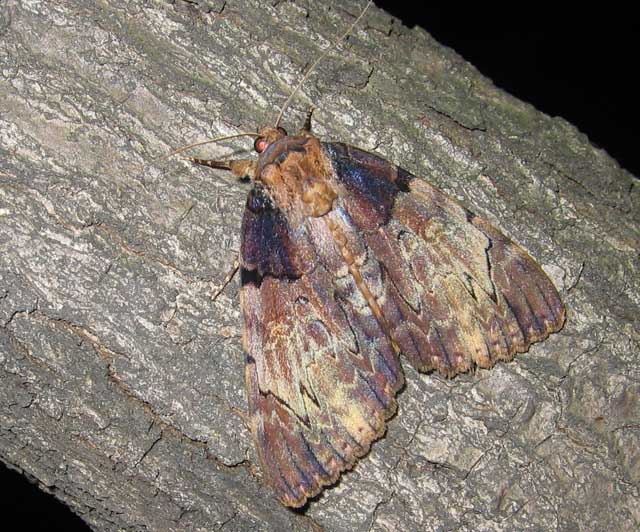
Catocala nebulosa, courtesy of Marie Winn.
They get their name Catocala, literally "beautiful hind wings", from the striking yellow, orange, pink, red or black velvet colouration of their lower wings, usually only visible in take-off, flight or landing or when nectaring at night.
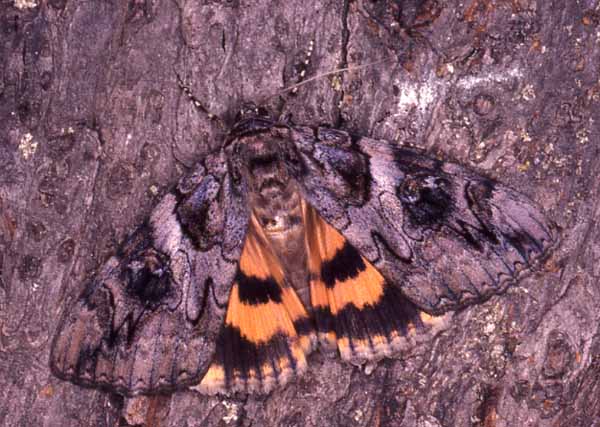
Those species listed without any reference initials are confirmed by John M. Nelson from his work at http://www.oklanature.com/jfisher/oklahoma_moth_species_by_county.pdf
Those species followed by (JMN) are from an earlier work by John M. Nelson and Peter Loy.
Those species followed by (GBG) are from Season Summary reports by Gary B. Gier.
Those species followed by (WO) = William (Bill) Oehlke are my own interpolations, i.e., species confirmed by one or more of the above authors in Oklahoma County and in Tulsa County have been added to the checklists for those counties between Oklahoma and Tulsa counties.
Many thanks to Susan Johnston who alerted me to the most recent publication by John M. Nelson. Susan is very appreciative of the lepidoptera in her area, and has sent me images and sightings of butterflies and Sphingidae.
Please send comments/corrections and/or images for inclusion or identification to Bill Oehlke. Over the next several years I hope to create pictoral checklists for each county. Those counties indicated in red are the only ones currently active with pictoral checklists. However, indidual species files usually contain images and considerable information.
As of April 4, 2010, this page has been further updated as per research data compiled by Larry Gall.
I would like to continue to refine the listings to county levels so images and data (date, location at least to county level,
bait, lights) would be very much appreciated. Please send same to Bill Oehlke.
All images that I use on my websites remain the property of respective photographers and images are credited as such.
The Identification Keys Diagram should help you understand the terminology I have used in describing the various species.
There is now a pictoral thumbnail checklist below the county by county listings.
Visit Oklahoma Sphingidae; Hawk Moths.
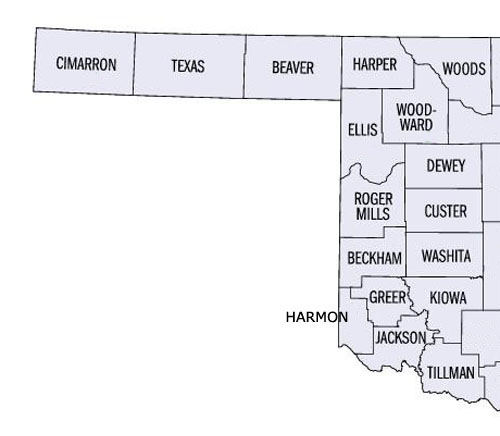
Cimarron |
Texas |
Beaver |
Harper |
Woods |
Central Oklahoma
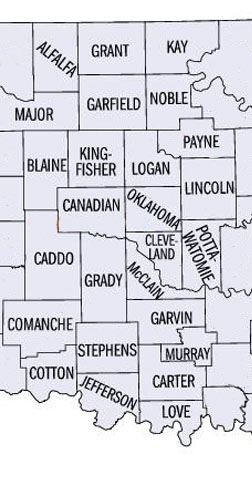
Eastern Oklahoma
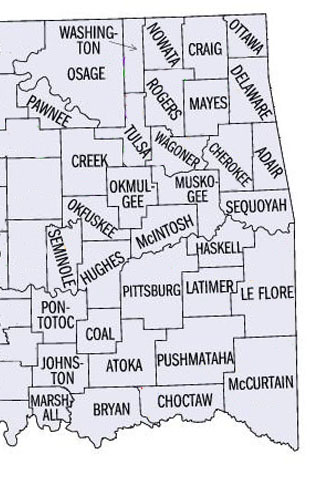
Little Yellow-Orange Underwings: Wingspans: 30-45mm
Little Yellow-Orange Underwings: Wingspans: 35-56mm |
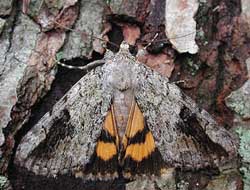
| ** 8876 Catocala micronympha, the Little Nymph Underwing, (wingspan: 35-50mm); John Himmelman image. Usual specimens have grey forewings shaded with green, brown, black and white tints. Usually a darkened band passing from costa through reniform spot to outer margin. High variability. Full size Joe Garris photo of C. micronympha form hero. |
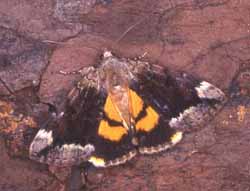
| ** 8876 Catocala micronympha
form gisela,
the Little Nymph Underwing, (wingspan: 35-50mm). |
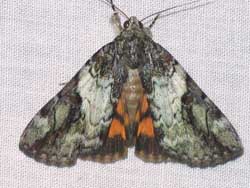
| ** 8876 Catocala micronympha
form hero,
the Little Nymph Underwing, (wingspan: 35-50mm).
The usual specimens have grey forewings shaded with green, brown,
black and white tints. There is usually a darkened band passing from
the costa through the reniform spot to the outer margin.
Form "hero" H. Edwards has a median area that is mostly white. |
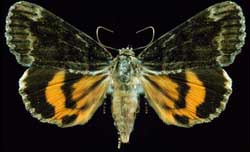
| ** 8876 Catocala micronympha form lolita, the Little Nymph Underwing, (wingspan: 35-50mm).Form "lolita" Sargent has very dark forewings. Harold J. Vermes image, used with permission from his son. |
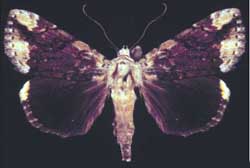
| ** 8876 Catocala micronympha form sargenti, the Little Nymph Underwing, (wingspan: 35-50mm). Usual specimens have grey forewings shaded with green, brown, black and white tints. Usually a darkened band passing from costa through reniform spot to outer margin. Form "sargenti" Covell (very rare) has a hindwing that is all black. |
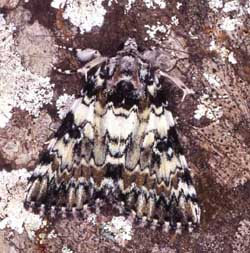
| ** 8877 connubialis, Connubial Underwing, (wingspan: 35-50mm). Fw highly variable; several different forms: "sancta": typical form, fws with white ground colour and sharply contrasting black lines and markings. Brown shading between post medial and subterminal lines; "cordelia": coloured as above, markings faint; "pulverulenta": grey-green fws with faint markings, sometimes none; "broweri": melanic form with fws dark green, almost black. Hw: separate anal spot, outer band ends with a straight cut. Leroy Simon image. |
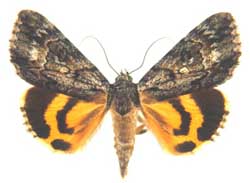
| ** 8848 bastropi, Bastroph Underwing, (wingspan: 40mm). There is a distinct white "smile" (in spread specimens) between the reniform and subreniform spots. There is also a narrow but distinct white line immediately following the black postmedial line. Hw deep yellow orange, outer black band interrupted, followed by dot, ending before im. replaces (2017) louiseae in Oklahoma |
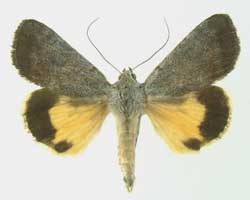
| messalina, Messalina Underwing, (40-45mm); The forewing is a plain, dull, grey-green, darkening toward the outer margin.The hindwing is like that of the false underwing, having no inner black band. The outer band is quite wide. C. messalina flies in evergreen oak habitats. |
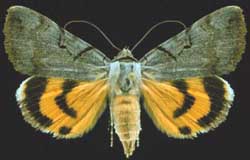
| ** 8841 Catocala abbreviatella; Abbreviated Underwing; 40-50mm. Fw uniformly colored with narrow black lines on anterior half. Brown reniform spot ringed with black. Hw outer black band abbreviated and then continued with dot. Inner black band terminates well before im. Similar species: C. nuptialis solid black reniform spot. C. whitneyi broad dark triangles mid fw. |
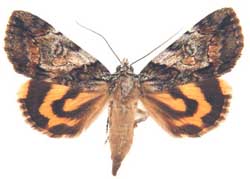
| Catocala pretiosa texarkana
Texas-Arkansas Underwing; 40-50mm;
The median area is quite light with a wide whitish band paralleling the antemedial line from the costa almost to the
inner margin. The subreniform spot is distinctly brown. |
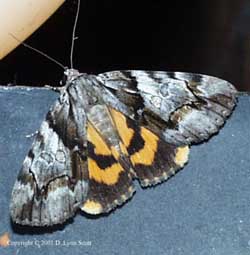
| ** 8867 Catocala blandula;
Charming Underwing, wingspan: 40-50mm. |
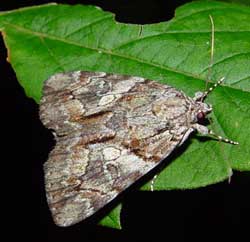
| Catocala mira; Wonderful Underwing, wingspan: 40-50mm. Pale basal area of fw distinguishes mira from blandula (dark brown) and crataegi (black). Fw lacks dark contrasting lines of crataegi and blandula. Considerable brown in subterminal area and subreniform spot very conspicuous, usually brown. Light area runs obliquely from costa to subreniform spot. Noticeable space along i. m. between antemedial and postmedial lines. Hw deep orange and has a complete inner black band. The outer black band is unbroken Tim Dyson image. |
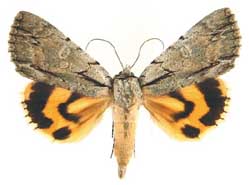
| ** 8772 clintoni; Clinton's Underwing; 45-55mm; The black basal dash distinguishes clintoni from illecta and abbreviatella, both of which lack the dash.Vernon Brou image. |
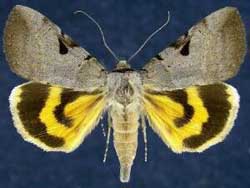
| ** 8858 Catocala nuptialis; Married Underwing, wingspan: 40-50mm
The reniform spot is very dark, black or almost black on an otherwise faintly marked, almost uniformly grey forewing.
The outer black margin of the hindwing is unbroken, but is indented near the anal angle. |
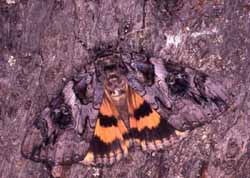 |
** 8844 amestris; Three-staff Underwing; wingspan 43-50mm.There is a large pale patch near the apex. In form "westcotti" the hindwing outer black band is complete. In other moths, the band is broken as in abbreviatella. Hindwing ground colour is usually deeper yellow-orange than in similar species. Leroy Simon image. |
Midsized Orange-Salmon-Red-Scarlet Underwings: Wingspans: 50-72mm
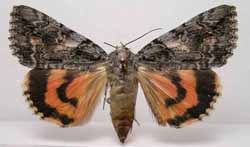
|
verrilliana; Verrill's Underwing;
45-60mm |
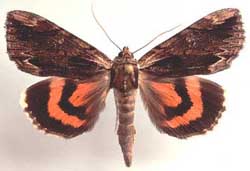
| ** 8857 Catocala ultronia There can be considerable variation from one specimen to the next. Underwings can be yellow to orange to salmon. |
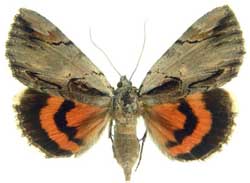
| ** 8857 Catocala ultronia form lucinda; Ultronia Underwing, wingspan: 50-63mm.In form lucinda most of the forewing is bright grey. On all forms there is
extensive orange-salmon colouration on hw ventral surface,
and there is a dark discal lunule. |
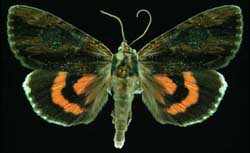
| Catocala ultronia, form nigrescens, the Ultronia Underwing, wingspan: 50-63mm. In the melanic form nigrescens, the dorsal forewing is very dark. Even darker subapical arc, basal dash and dash near anal angle are still visible. Dark basal hairs on hindwing. Harold J. Vermes slide, used with permission from his son. |
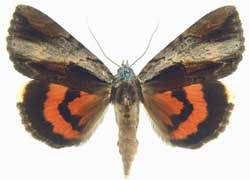
| Catocala ultronia form celia.
In form celia there is a wide, light grey band separating a dark region along inner margin and
a dark patch near the apex.
The ventral surface of forewings of all forms has a generous suffusion
of orange-salmon scales in the lower half of the median area. |
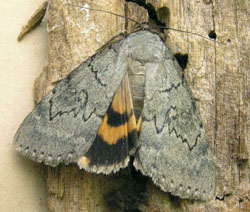 |
** 8779 serena Serene Underwing. Head & collar & abdomen are brown while thorax is grey. Am & pm lines are thin, very dark, distinct on an otherwise drab, almost uniformly olive-grey fw. Black marginal band of lower wings is indented at center, relatively narrow, deep yellow median band parallels indentation. Basal hairs are brown. |
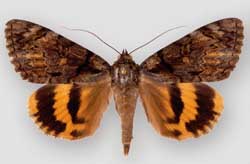
| Catocala delilah; 58-65; The forewing is gray-brown with prominent black antemedial and postmedial lines. The hindwing is yellow-orange, with a narrow inner black band which reaches the inner margin. There is a large yellow spot at the apex, and the fringe is faintly barred. The underside of the wings is deep yellow with black bands. |
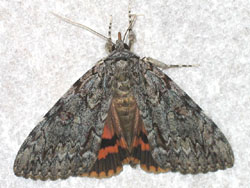
| #8795 Catocala palaeogama ; wingspan: 60-70mm. Subreniform spot closed, does not approach pm line, is smaller than in C. habilis. All forms have characteristic orange, heavily barred fringe to apex, and irregular bands on hws. Hw basal median area heavily suffused with dark brown to black scales. Dark bar in outer half of median area, paralleling i. m. halfway between i. m. and light, closed subreniform spot. Joe Garris photo. |
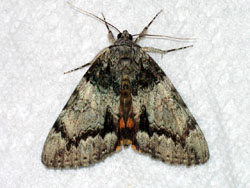
| #8795 Catocala palaeogama form phalanga; wingspan: 60-70mm. In this form, fw basal area and subterminal area are very dark against a much lighter background. Dark bar in the outer half of the median area, paralleling the inner margin halfway between the inner margin and the light, closed subreniform spot is especially evident. Joe Garris image. |
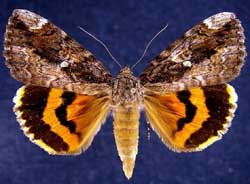
| ** 8770 Catocala innubens; Betrothed; 55-72mm. Forewing is mottled with white, grey and brown, and subrenifrom spot tends to be lighter in colour, although it is sometimes obscured by an indistinct blackish bar which runs from middle of basal/thorax connection to just below much lighter apex at outer margin.Jim Vargo image. |
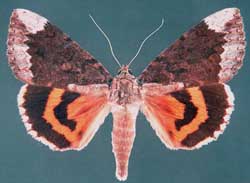
| ** 8770 Catocala innubens form scintillans; Betrothed; 55-72mm.In form scintillans most of the basal area (all but lower third) and all of the median area of the forewing is dark reddish brown. The area outside the pm line is grey. Vernon A Brou image. |
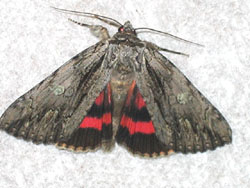
| ** 8851 Catocala coccinata; Scarlet; 57-70mm: Diffuse basal, anal dashes on otherwise light grey, mottled fw. Hw fringe white (often with some salmon scaling), heavily checked. "Tooth" just below pair of very elongated "teeth" is much reduced, quite rounded, usually allowing considerable room for lighter patch of scales. Dark bar crosses thorax. Reniform spot light, often with greenish cast. Joe Garris image. |
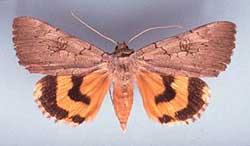
| ** 8840
Catocala illecta;
Magdalen Underwing, 60-70mm:
The forewing pattern and colouration is much like that of concumbens,
pale grey with faint black lines. |
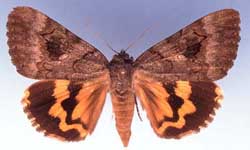
| ** 8772 Catocala consors; Consort, wingspan: 70mm plus. Fw with irregular am and pm narrow black lines. Dark patch outside the reniform and subreniform spots. The orange-yellow hindwing pm band tends to be narrow and irregularly zigzagged. Sometimes the band is wider and slightly less irregular. James K. Adams image. |
Solid Black Underwings: Smallest to Largest, Similar Species Paired
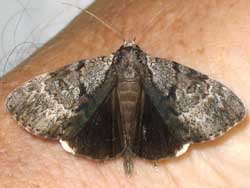
| Catocala andromedae, Gloomy Underwing, (wingspan: 40-50mm). Black underwings and dark grey fringe of hws, coupled with dark inner margin of forewings help to identify this species. There is also a very dark "flying saucer" shape, adjoining subreniform spot to midpoint of am line. The "teeth" of pm line short and blunt, outwardly edged with white. Subterminal line is also outwardly edged with white. |
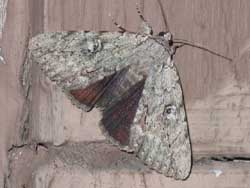
| ** 8781 judith, Judith's Underwing, (wingspan: 45-55mm), yes, small "black" underwing. FW uniform light grey with thin, only slightly darkened am, median and pml lines. No darkened dashes (slight anal dash) or transverse lines. Reniform area slightly darkened while area just before subterminal line is bit lighter. Note absence of hw white fringe. Joe Garris photo. yes |
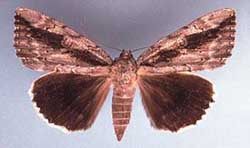
| ** 8782 Catocala flebilis, yes; Mournful, wingspan: 54-65mm. Diffuse black band runs from basal area to outer margin just below apex, interrupted by pale grey subreniform spot. Reniform spot is filled with brown; there is additional brown outside postmedial line. No anal dash as there is in angusi. The hindwings have white fringe. J. K. Adams image. |
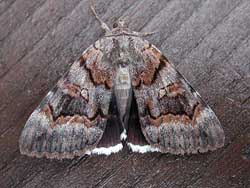
| ** 8773
Catocala epione :
Epione Underwing, wingspan: 55-65mm |
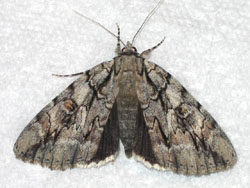
| Catocala retecta; wingspan: 60-75mm. Note light coloured, elongated and open subreniform spot which interrupts dark, diffuse ark running through center of wing from basal area (body-wing juncture) to fw apex. Center of reniform spot brown and there is a brown area just below costa running to inner margin just outside pm line. Off-white hindwing fringe only lightly checked along wing veins. Joe Garris image. |
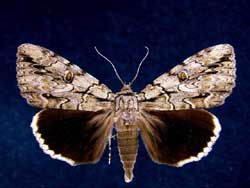
| Catocala luctuosa; 70mm: Light grey (yellowish tint) fw clearly marked with basal dash continuing with another dash through am line, then another anal dash almost forming bar parallel to the im. Hw fringe white & only lightly barred at veins. The "teeth" in the forewing postmedial line are elongated and dark, continuing a dark dar emanating from the outer margin just below the apex. |
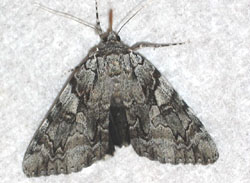
| Catocala dejecta, yes, (wingspan: 56-73mm; Hodge #8790). Dejected Underwing quite similar to Catocala retecta. Light coloured subreniform spot also open, but has distinct "pork-chop" shape and separates much darker median area below subreniform spot from very light area to costa above spot. Lower quarter of submarginal area much darker in C. dejecta than in C. retecta. |
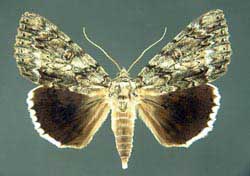
| ulalume; Ulalume Underwing; 62-75mm: The forewing colouration is a mottled light to dark grey with no strongly contrasting lines, dashes or bars. At the inner margin the antemedial line ends with in a very light coloured crescent. The subrenifrom spot is also light coloured and "comma" shaped. The hindwing is black and the fringe is pure white with thin, sharp (pointed) checking. |
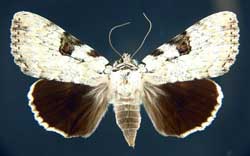
|
Catocala sappho;
Sappho Underwing; 60-75mm: |
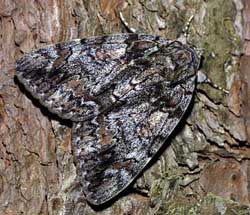
| ** 8794
Catocala lacrymosa;
Tearful Underwing, 60-82mm.
The forewing is highly variable with a mixture of black, brown
(wing tips and outside postmedial line) and dark grey scaling.
There are usually whitish crescents, along the inner margin at the
base of the antemedial and postmedial lines. |
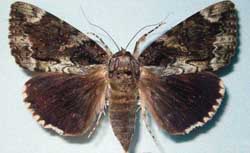
| ** 8794
Catocala lacrymosa;
Tearful Underwing, 60-82mm.
Form paulina: lighter grey post median area & area along and parallel to inner margin, in sharp contrast to
darker basal median areas. |
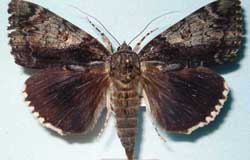
| ** 8794
Catocala lacrymosa;
Tearful Underwing, 60-82mm. |
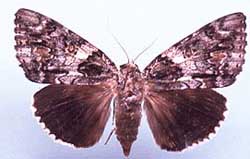
| ** 8794 Catocala lacrymosa; Tearful Underwing, 60-82mm;; GSMNP/TP/WAM/KC. In form albomarginata there is an abundance of white scaling on the forewing. |
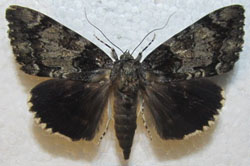
| ** 8794 Catocala lacrymosa; Tearful Underwing, 60-82mm;; TP. Form "zelica", has black basal patch and strong black subterminal line. |
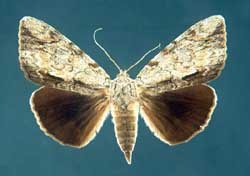
| ** 8791
Catocala insolabilis;
Inconsolable, wingspan: 65-75mm;
Fw light grey with blackish shading along inner
margin. Am and pm lines are thin.
Hw fringe is very narrow and grey, becoming whiter toward
the apex.
The ventral surface clearly distinguishes insolabis, being almost
completely black except for some white in the basal area. |
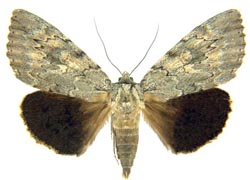
| ** 8780 Catocala robinsoni; 70-80mm. Fws relatively plain pale grey. Female has basal dash, absent in male. Currata French, 1882, female form: weak basal dash. Rare form missouriensis Schwarz, 1915: dark, broad bar extending from basal area to o.m. just below apex. Lighter grey rnfm, subrnfm spots break bar in missouriensis, found from PA. to FL. Hw fringe: White; bands on ventral surface prominent. |
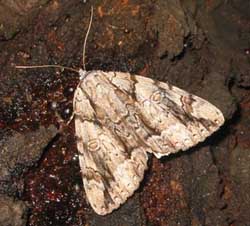
| ** 8792 Catocala vidua; Widow; 70-80mm. Fw ground colour light grey. Distinguishing dark arc runs through top of reniform spot to just below apex. Heavy, dark anal and basal dashes, connecting to dark median bar, running parallel to i. m. Am line thick, black in its upper half. Reniform spot with two almost concentric irregular ovals. Subreniform spot light, open, constricted as it meets pm line. Hw black with broad, white fringe, lightly interrupted. Marie Winn image. |
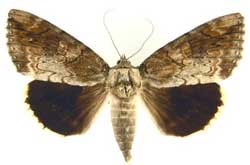
| Catocala atocala, Underwing, (wingspan: approximately 70-75mm). Similar to agrippina, but reniform is more clearly defined in atocala. Closed subreniform of atocala may be open or closed in agrippina. Distinct basal dash of agrippina females is nearly absent in atocala females. Hw undersurface white areas on agrippina are beige on atocala. Hw bulge (discal spot) on atocala, is not present on agrippina. |
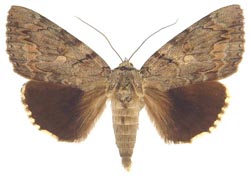
| Catocala agrippina; 75-85mm; In the male, the fws are grey-black with some reddish brown (distinguishing characteristic); am and pm lines are black, darker toward costa, much lighter near inner margin. Reniform is indistinct and brown; sub-reniform is almost obsolete, but lighter than surrounding areas. Hws are black, with greyish hairs at base and im. Fringe is white, only partly cut with black at terminations of veins. |
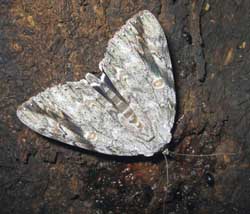
| ** 8793 Catocala maestosa. Sad Underwing, 78-98mm: Maesotsa is quite similar to, although usually larger than, vidua. Both have the dark arc from the costa, above the reniform spot, to the outer margin just below the apex. Maesotsa, however, lacks the dark bar, found on vidua, parallel to the inner margin. The reniform spot is brown and there is brown shading just outside the postmedial line. The hindwing fringe is white, narrow and heavily barred. |
Large Black Underwings (Banded): Wingspans: 70-80mm
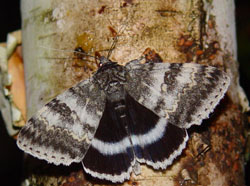
| ** 8803 Catocala relicta
;
Forsaken, White, Relict; 70-80mm:
Considerable variation with regard to black/white
concentrations on fws. |
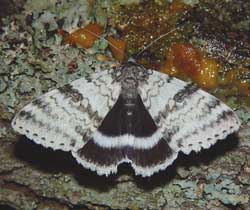
| ** 8803 Catocala relicta ; Forsaken, White, Relict; 70-80mm: Considerable variation with regard to black/white concentrations on fws. Form clara: basal and subterminal areas predominantly white.Typical specimens have basal and subterminal areas with blackish scales. Black hws, with brilliant even white inner band and white fringe, are distinctive. June until October. |
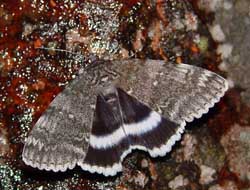
| ** 8803 Catocala relicta ; Forsaken, White, Relict; 70-80mm: Considerable variation with regard to black/white concentrations on fws. Form phrynia: evenly dusted with grey over entire forewing. Typical specimens have basal and subterminal areas with blackish scales. Black hws, with brilliant even white inner band and white fringe, are distinctive. June until October, poplars and willows |
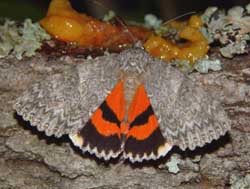
| ** 8822 meskei; Meske's Underwing; 65-75mm. Fws less distinctly marked compared to unijuga, some red-orange at the hindwing apex and just inside the fringe along the outer margin in meskei that is lacking in unijuga. Fw subreniform spot is opened or connected to the postmedian line. The hindwing postmedian band nearly straight, turned in and tapering near anal angle. Tim Dyson image. |
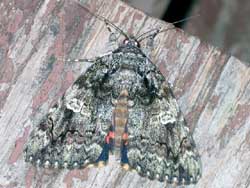
| ** 8801 Catocala ilia; Ilia; wingspan: 65-82mm. Several different forms, most have characteristic white area in and around reniform spot. Diffuse dark arc running from this spot to just below apex. Subreniform spot squarish, concave inner and outer edges and elongated constriction connecting it to pml. White dots near fw om in character with the overall "contrasting" appearance. |
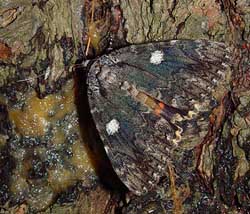
| ** 8801 Catocala ilia; Ilia; form conspicuaIn this form the entire reniform spot is heavily suffused with white scaling on an otherwise darker ground colour. Hence the form name "conspicua". Tim Dyson image. |
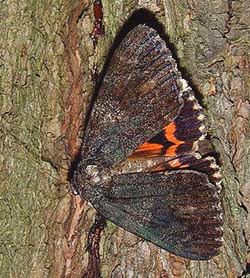
| ** 8801 Catocala ilia; Ilia; form satanasIn this melanic form the entire forewing, including the reniform spot is very dark. Hence the form name "satanas". The dark basal streak is still evident on this form. Tim Dyson image. |
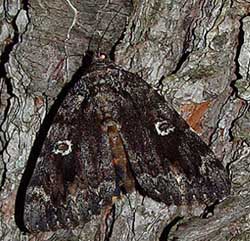
| ** 8801 Catocala ilia; Ilia; form normaniIn this semi-melanic form the entire forewing, excluding the reniform spot, is relatively dark. The brownish, kidney-shaped center of the reniform spot is outlined in white. The basal streak and subapical arc are still visible. Tim Dyson image. |
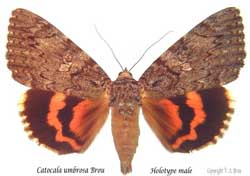
| ** 8857.1 Catocala umbrosa; mm; Double brown am line, inward line fainter, filled with off white; reniform spot brown center outlined in black , off white and black again; subreniform, large, pale brown, closed. Pm line wit htwo elongated upper teeth, next tooth reduced, next two progressively longer, rounded, final lobe rounded and shorter. HW with dark scaling/hairs in basal median area along im |
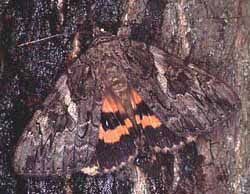
| ** 8771 Catocala piatrix ; Penitent, wingspan: 68-84mm. Fw: light-colored band/bar extending from light coloured, triangular subreniform spot along am line to costa. Brown, kidney-shaped reniform spot surrounded in pale grey, outlined in black, usually with distinct black along wing veins in a dark area outside the reniform spot. Hw: fringe lightly barred; lighter in color than deeper orange on rest of wing. |
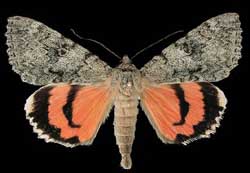
| Catocala junctura; Joined Underwing; 67-85mm; Fw usually dark brownish-gray to evenly powdered blue-grey w/o significant markings. Doubled reniform spot often obscure. Thin, slightly darker am/pm lines from costa to im, not widely spaced at im. Hw salmon or orange-pink with narrow inner black band that turns in sharply, does not meet dark-haired im, distinguishing it from unijuga. |
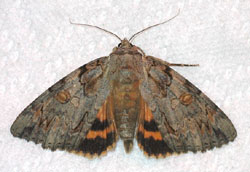
| ** 8798 Catocala neogama; wingspan 70-85mm. Brown head, thorax, larger size as compared to C. palaeogama. Neogama tend to be slightly smaller than subnata, have darker grey brown fws with more pronounced markings. Examination of hind tibia needed for id. Neogama's: flattened, unevenly, sparsely spined; subnata's: cylindrical, spines dense, uniform in distribution. Joe Garris photo. |
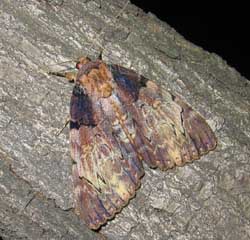
| Catocala nebulosa; Moths have prominent dark brown upper-half-basal patch that extends to and ends at antemedial line. Apical area also tends to be brown, much darker than median area but not as dark as basal patch. The anal angle also has the darker brown scaling. The pm line is distinct near costa and inner margin, but becomes weak between the two. It meets inner margin in relative close proximity to am line. Closed subreniform spot is large and connects to the pm line via a thin line. |
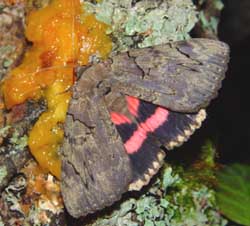
| ** 8832 Catocala cara; Darling; wingspan 70-85mm: Note deep maroon almost purple cast to forewings, mixed with very pale green. Lower half of am and pm lines is barely visible. No distinctive bars or dashes. Two upper "teeth" on pm line are thin and long. Hw bands are pink. Heavy black checking on the off-white hindwing fringe. The relatively thick black median band of the hindwing almost reaches the inner margin which is usually heavily adorned with dark hairs. Tim Dyson image. |
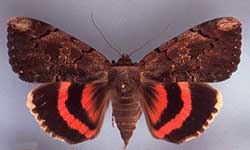
| ** Catocala carissima; wingspan 70-85mm. Distinct light grey brown area at fw apex, preceded just inside pm line by slightly darker patch. Am and pm lines sharp and dark. Hw inner black band wide, complete, merges with extensive grey-black scaling along im. Hw fringe cream coloured. |
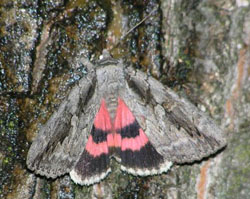
| ** 8834 amatrix Sweetheart Underwing; (wingspan 75-95mm). Very skittish, frequently hides in caves, under bridges, under tree bark, etc. by day, resting with head down. Hw patterning and colouration similar to that of C. concumbens, but large size (wingspan 75-95mm) and dark bar running from basal area to just below apex distinguishes C. amatrix. See large Catocala amatrix courtesy of Joan F. Rickert. |
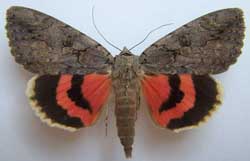
| ** 8834 amatrix form selecta
Sweetheart Underwing; (wingspan 75-95mm) |
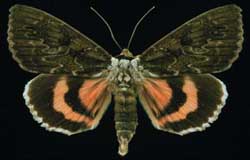
| ** 8834 amatrix form hesseli
Sweetheart Underwing; (wingspan 75-95mm) |
This page brought to you by Bill Oehlke and the WLSS. Click on the flashing butterfly to show appreciation for and to promote this site.Enjoy one of nature's wonderments: Live Saturniidae (Giant Silkmoth) cocoons. |

|
Credits and notes:
John M. Nelson and Peter W. Loy
The following information is taken (copied) from http://digital.library.okstate.edu/OAS/oas_pdf/v63/p60_67.pdf
Records of 34 species of Catocala collected in Oklahoma are presented. They are Catocala abbreviatella, C. agrippina, C. amatrix, C. amestris, C. amica, C. andromedae, C. cara, C. coccinata, C.connubialis, C. consors, C. dejecta, C. delilah, C. epione, C. frederici, C. herodias, C. ilia, C. illecta, C.innubens, C. insolabilis, C. judith, C. junctura, C. lacrymosa, C. maestosa, C. micronympha, C. nebulosa, C.neogama, C. nuptialis, C. palaeogama, C. piatrix, C. robinsoni, C. similis, C. ulalume, C. ultronia, C. vidua. Brief descriptions, county records, and a key to the species listed are included.
The Catocala have been divided into groups based on the larval food (7). Our data show that the hickory-walnut feeders are the most numerous species in the state with the oak feeders next most abundant. The number of species in the eastern U.S. appears to be greater than in the midwest and west but this may be the result of more intensive collecting there. More than 50 species have been reported from the state of New York (4), whereas we have now obtained records of only 34 species of Catocala in Oklahoma.
We estimate that this represents about 65-75% of the total in the state. More species are expected to be in the eastern half of the state, where the food plants are more readily available. Our collecting methods have been limited to collecting around lights, both black and white, and examining the trunks of large trees in suitable habitats. Neither of us has used the "sugaring" method espoused by some collectors (8). Most of our collecting activities have been confined to northeastern Oklahoma. Additional records have been obtained from various institutions in the state and are identified in the species list. We have prepared a key to all the species collected in the state. It will need to be modified as more species are taken. The authors solicit additional state and county records and will be glad to make determinations of specimens. An annotated list of the species is given. No illustrations are presented here, as color plates of all species are readily available (7,8,9). We have tried to give the more obvious distinguishing characteristics of each species, including wing span. Barnes and McDunnough (7) divided the genus into three sections on the basis of leg spination as follows: Section 1—all tibiae spined and tarsi having a fourth row of irregular spines; Section 2—fore tibia unspined and tarsi with only three rows of spines; Section 3—both fore and hind tibia without spines.
Only a few generalizations can be
made at this time regarding our local fauna. These include the
following:
1. Wing span (size) is rather consistent in these moths
and can be used to place them in the right species in many cases.
2. All the hickory, pecan, and walnut feeders fall in Section 1 with
only one other species (C. innubens) assigned to this group.
3. All species with black hind wings, except—C. andromedae, are in
the hickory- and walnut-feeding group.
4. The patterns, colors, and presence of hairs on the undersides of
the wings may be as helpful, or more so, in identifying species than
those on the upper sides.
HICKORY AND WALNUT FEEDERS
Catocala piatrix Grote Wing span 70-80 mm. FW dark brown-gray, darkest at base with a light band extending diagonally inward from the reniform to costal margin; HW dark yellow or yellow-orange with black hands and dark basal hairs. Records: Hinton, Caddo Co., July, OSU; Thomas, Custer Co., July, OSU; Chickasha, Grady Co., October,USAO; Claremore, Rogers Co., July-August.
Catocala consors (Smith & Abbot) Wing span 60-70 mm. FW dark gray, with black am and pm lines, brown band outside pm line, reniform light; HW yellow-orange with pm orange band narrowed and irregularly zigzagged. Records: Muse, LeFlore, Co., June, OSU; Sherwood, McCurtain Co., June, OSU; Ft. Gibson, MuskogeeCo., July, OSU.
Catocala epione (Drury) Wing span 55-65 mm, HW black with pure white fringe and no barring makes this species easy to identify. Records: Tahlequah, Cherokee Co., June; Muse, LeFlore Co., June, OSU; Game Refuge, McCurtain Co.,July, ECU; Stillwater, Payne Co., June-August, OSU; Pontotoc Co., June, ECU; Claremore, Rogers Co., June-July; Lake Bixhoma, Wagoner Co., June. Taken on tree trunks and at light.
Catocala robinsoni Grote Wing span 60-75 mm. FW above light gray to brownish, anterior half of am and pm lines black, with light brown band outside pm line; HW black with lightly barred white fringe and a light dusting of gray hairs at base; wings beneath with prominent light cream bands, innerband on FW wide and ending abruptly before reaching inner margin, outer band narrows to a point at inner margin. Record: Tulsa, Tulsa Co., July.
Catocala judith Strecker Wing span 45-50 mm. FW uniformly colored light gray with some black spots or lines; HW black, without white apex; underwings black with bands pale or indistinct and heavy gray shading at bases. Records: Chickasha, Grady Co., July, USAO.
Catocala agrippina Strecker Wing span 75-85 mm. FW gray-brown; HW black with barred white fringe; wings more yellow than white beneath with pm band narrow and irregular. Records: Ft. Gibson, Muskogee, July, OSU; Stillwater, Payne Co., June-July, OSU; Pontotoc Co., June; ECU;Claremore, Rogers Co.; Grandfield, Tillman Co., July, OSU; Bixby, Tulsa Co., July. Taken on tree trunks in woods.
Catocala ulalume Strecker Wing span 60-70 mm. FW dark gray with a conspicuous, wide white line extending from reniform obliquely inward to costal margin; HW black with narrow white fringe. Records: Ada, Pontotoc Co., July, OSU.
Catocala dejecta Strecker Wing span 60-70 mm. FW dark gray with a conspicuous, wide white line extending from reniform obliquely inward to costal margin; HW black with narrow white fringe.Records: Robbers Cave State Park, Latimer Co., September.
Catocala insolabilis Guenée Wing span 65-75 mm. HW black with dusky fringe; undersides of wings all black except for whitish basal area. Records: Chickasha, Grady Co., July, USAO; Ada, Pontotoc Co., July, OSU.
Catocala vidua (Smith and Abbot) Wing span 70-80 mm. FW light gray with prominent black markings; HW black with white fringe and inconspicuous barring; HW beneath with basal area dark gray; white pm band of both wings wide.Records: Osage Hills State Park, Osage Co., October; Stillwater, Payne Co., September, OSU.
Catocala maestosa (Hulst) Wing span 80-90 mm. This is our biggest Catacola. FW light gray, similar to C. vidua; HW more heavily barred on white fringe and with a heavy dusting of contrasting gray hairs at base above. Records: Hinton, Caddo Co., July, OSU; Sequoyah State Park, Cherokee Co., September; Game Refuge, McCurtain Co., June, ECU; Stillwater, Payne Co., Fenton (6) as C. viduata, and August, OSU; Ada, Pontotoc Co.,July, OSU; Claremore, Rogers Co., July-August; Bixby, Tulsa Co., September. Taken on tree trunks in heavily wooded areas.
Catocala lacrymosa Guenée Wing span 60-70 mm. FW dark gray, often marked with brown and with a heavy black pm line; HW black with barred white fringe; FW yellow below with pm band incomplete; HW below white with narrow, irregular pm band. Records: Ada, Pontotoc Co., July, OSU; Bixby, Tulsa Co., September. Taken at black light.
Catocala palaeogama Guenée Wing span 60-70 mm. FW variable in color from light gray to dark gray, with heavy black am and pm lines; HW orange with orange apex and fringe, basal area covered with dark hairs; basal area of both wings below with gray hairs. Records: Tahlequah, Cherokee Co., June; Chickasha, Grady Co., July, USAO. Taken at light and on tree trunk.
Catocala nebulosa H. W. Edwards Wing span 75-85 mm. Readily recognized by the reddish-brown FW with a deep brown basal area and darkbrown triangle at apex, anal angle may be darker also; HW yellow with black bands and dark hairs at base. Records: Spring Creek, Mayes Co., August; Game Refuge, McCurtain Co., July, ECU.
Catocala neogama (Smith & Abbot) Wing span 70-85 mm. FW medium to dark gray with brownish markings; HW dark yellow-orange with lighter fringe, lightly barred; pm band narrow, irregular, heavy dusting of dark hairs at base and along inner margin; undersides light yellow-orange and black. Records: Hinton, Caddo Co., July, OSU; Ada, Pontotoc Co., July, OSU.
OAK FEEDERS Section 2 species
Catocala ilia (Cramer) Wing span 70-80 mm. Color and pattern of FW variable; HW orange with inner black band somewhat moniliform; underside of FW with some red or orange color present. Records: Little River State Park, Cleveland Co., June; Wichita Mountains, Comanche Co., June, OSU; Zena,Delaware Co., June; Muse, LeFlore Co., July, OSU; Locust Grove (Spring Creek), Mayes Co., July-August;Eagletown, McCurtain Co., June, OSU; Stillwater, Payne Co., June, OSU; Ada, Pontotoc Co., July, OSU; Claremore,Rogers Co., June; Bixby and Tulsa, Tulsa Co., May-June.
Catocala delilah Strecker Wing span 60-65 mm. FW gray-brown with prominent black am and pm lines; HW deep yellow, inner black band narrow and reaching inner margin, large yellow spot at apex, barring on fringe faint; underside of wings deep yellow with black bands. Records: Ardmore, Carter Co., June, OSU; Wichita Mountains, Comanche Co., June, OSU; Stillwater, PayneCo., OSU. Taken at bait.
Catocala frederici Grote Wing span 40-50 mm. FW yellowish-brown; HW yellow with narrow black bands, both ending before reaching inner margin, small dot at anal angle; undersides colored as above with hind wing marked like upper side. Record: Lugert, Kiowa Co., June, OSU. This is a western species.
Catocala herodias Strecker Wing span 55-65 mm. FW dark gray, appears narrowly striped on posterior half; HW dark red to crimson with inner black band narrowed and scalloped; undersides bright red with black bands.Record: Stillwater, Payne Co., June, OSU.
Catocala coccinata Grote Wing span 60-70 mm. Ground color of HW deep red; FW with underside reddish; HW beneath whitish on upper half and red on lower half. Records: Little River State Park, Cleveland Co., June; Wichita Mountains, Comanche Co., June, OSU; Marshall Co., June, OUBS; Stillwater, Payne Co., May, June, OSU. At black light.
Section 3 Species
Catocala similis W. H. Edwards Wing span 40-45 mm. FW has small pale triangle along costa at apex, reniform, appears drop-shaped; outer blackband of HW broken with a prominent anal spot; inner black band not extending to edge of wing. Records: Hinton, Caddo Co., June, OSU; Locust Grove (Spring Creek), Mayes Co., July; Payne Co., June, OSU.At black light.
Catocala connubialis Guenée Wing span 40-45 mm. FW variable, light to dark gray and with or without markings; HW yellow-orange with innerblack band narrow and sometimes ending before reaching margin, a line of black hairs from inner band, just inside inner margin, back to base; outer black band wide, terminating abruptly and squarely, and leaving a black spot at anal angle. Record: Stillwater, Payne Co., June, OSU. Taken at light.
Catocala micronympha Guenée Wing span 40-50 mm. Wing coloration highly variable with numerous "'forms" described. FW usually with light colored st line; HW has broad outer band broken with a prominent anal spot, and inner band extending sharply back from nearanal angle to base. Records: Wichita Mountains, Comanche Co., June, OSU; Lugert, Kiowa Co., June, OSU; Muse, LeFlore Co.,June, OSU; Locust Grove, Mayes Co., July; Claremore, Rogers Co., June; Bixby, Tulsa Co., June. All taken at blacklight.
Catocala amica (Hübner) Wing span 35-40 mm. Easily distinguished by its size and lack of an inner black band on HW. FW quite variable in color and pattern. Records: Hinton, Caddo Co., July, OSU; Tahlequah, Cherokee Co., July; Little River State Park, Cleveland Co.,June; Muse, LeFlore Co., June, OSU; Oswalt, Love Co., July, OSU; Stillwater, Payne Co., June-July, OSU; Ada,Pontotoc Co., July, OSU; Locust Grove, Mayes Co., July. All taken at black light.
HONEY LOCUST AND LEAD PLANT FEEDERS Section 1 Species
Catocala innubens Guenée Wing span 55-70 mm. FW variable in color and pattern, usually with a light triangle at apex above; HW with orange ground color and heavy shading of dark hairs at base; underside of HW with cream-colored ground on upper half and orange on lower half. Records: Little River State Park, Cleveland Co., June; Stratford, Garvin Co., May, OSU; Chickasha, Grady Co.,July, USAO; Locust Grove (Spring Creek), Mayes Co., July; Ft. Gibson, Muskogee Co., July, OSU; Ada, PontotocCo., July, OSU; Claremore, Rogers Co., June-July. Taken at black light and sitting on tree trunks.
Section 2 Species
Catocala illecta Walker Wing span 60-70 mm. FW light gray with narrow black lines; ground color of HW yellow, with inner black band wide and ending before inner margin. This species is different from the others in the section in that it has 4 rows of tarsal spines. Records: Grant, Choctaw Co., July, OSU; Locust Grove and Chouteau (OSU), Mayes Co., May; Stillwater, Payne Co., May-June, OSU; Claremore, Rogers Co., June. Taken both at black light and under bright lights.
Catocala abbreviatella Grote Wing span 40-50 mm. FW light gray with black lines on anterior half; HW light yellow-orange with narrowed black bands, both ending before reaching margin; black spot at anal angle. Records: Hinton, Caddo Co., June, OSU; Lake Carl Blackwell, Payne Co., June, OSU.
Catocala nuptialis WalkerWing span 40-50 mm. FW light gray with black reniform spot and black lines on anterior third; HW yellow ground with broad, continuous outer black band; inner band also broad, rather smooth, ending before margin. Record: Bixby, Tulsa Co., July. Taken at black light.
Catocala amestris Strecker Wing span 45-50 mm. FW gray above with heavy dark brownish-black markings on anterior half, resulting from adoubling of am and pm lines and the reniform, demarking these dark areas; HW yellow-orange with inner black band narrowed and angulate, but smoothly outlined; outer black band broad with anal spot. Records: Hinton, Caddo Co., June, OSU; Wichita Mountains, Comanche Co., June, OSU; Stillwater, Payne Co.,June, OSU. Taken at black light.
WILLOW AND POPLAR FEEDERS Section 2 Species
Catocala junctura Walker Wing span 70-75 mm. FW delicate gray-brown, HW red-orange with narrow inner black band not reaching margin but hooked back toward base; underside of FW white, HW white on anterior one-fourth and red-orange on rest of wing; both wings with prominent black bands; inner black band on underside of HW just like the one on upper side. This species is in a group of willow feeders having 28 species of which 20 are western in distribution. We expect that this will be the western range limit of this eastern species. Records: Sequoyah State Park, Cherokee Co., September; Weatherford, Custer Co., OSU; Stillwater, Payne Co.,July, OSU; Pontotoc Co., June, ECU; Tulsa, Tulsa Co., July. On trees in dense woods beside lake.
Catocala cara Guenee Wing span 70-85 mm. FW dark brown, HW deep pink with broad, even black bands, and heavy dusting of dark hairs at base. Records: Locust Grove (Spring Creek), Mayes Co.; Game Refuge, McCurtain Co., June, ECU; Claremore,Rogers Co., July.
Catocala amatrix (Hubner) Wing span 75-85 mm. FW similar to C. cara but usually lighter and more gray; HW lighter pink with black bands more irregular in shape and lacking the dark hairs at the base. Records: Thomas, Custer Co., July, OSU; Ft. Gibson, Muskogee Co., July, OSU; Okemah, Okfuskee Co., July,OSU; Stillwater, Payne Co., July, OSU; Ada, Pontotoc Co., July, OSU; Claremore, Rogers Co., July-August; Bixbyand Tulsa, Tulsa Co., September; Bartlesville, Washington Co., July. Taken at lights and on trees.
BLUEBERRY (VACCINIUM) FEEDERS
Catocala andromedae (Guenée) Wing span 40-50 mm. Section 2. FW with contrasting light shading; HW black with white apex; underside of both wings black with white apex and broad, whitish outer band on FW only.Record: Tahlequah, Cherokee Co., June. At light.
ROSACEAE FEEDERS
Catocala ultronia (Hübner) Wing span 50-60 mm. Section 3. FW above quite variable, gray to brown to dark brown, but darkened along area of basal dash and with a lighter brown patch at apex; HW orange-red with complete black bands and gray fringe with a white spot at apex. Records: Hinton, Caddo Co., June, OSU; Wichita Mountains, Comanche Co., June, OSU.
ACKNOWLEDGMENTS
Appreciation is expressed to the following individuals who allowed us access to collections under their supervision:
Dr. William Carter, East Central University, Ada;
Dr. William Drew, Oklahoma State University, Stillwater;
Dr. Rod Stewart, University of Oklahoma Biological Station, Lake
Texoma;
and Dr. C. M. Mather, University of Science and Arts in
Oklahoma, Chickasha.
REFERENCES
1. W. A. DREW, Proc. Okla. Acad. Sci. 42: 93-100 (1962).
2. R. BURTON and W. A. DREW, Proc. Okla. Acad. Sci. 48: 16-22 (1969).
3. J. M. NELSON, Proc. Okla. Acad. Sci. 59: 41-46 (1979).
4. W. L. BAKER, Eastern Forest Insects, USDA Misc. Pub. No. 1175,
1972.
5. R. L. FURNISS and V. M. CAROLIN, Western Forest Insects,
USDA Misc. Pub. No. 1339, 1977.
6. F. A. FENTON, Proc. Okla. Acad. Sci. 19: 71-77 (1939).
7. W. BARNES and J. McDUNNOUGH, Mem. Am. Mus. Nat. Hist. 3: 1-47
(1918).
8. T. D. SARGENT, Legion of Night: the Underwing Moths, Univ. of
Massachusetts Press, Amherst, 1976.
9. W. J. HOLLAND, The Moth Book, Doubleday, New York, N.Y., 1903.
(Reprinted and emended 1968, Dover,paperback, New York.)
Use your browser "Back" button to return to the previous page.
Lep soc season summary
Cleveland Catocala dejecta 10 mi E of Norman 04-JUL-96 Gier, Gary B. 1997 Cleveland Catocala lacrymosa 10 mi E of Norman 04-JUL-96 Gier, Gary B. 1997 Cleveland Catocala ulalume 10 mi E of Norman 04-JUL-96 Gier, Gary B. 1997 Murray Catocala agrippina vic of Sulphur 02-JUL-96 Gier, Gary B. 1997 Murray Catocala maestosa vic of Sulphur 02-JUL-96 Gier, Gary B. 1997
Use your browser "Back" button to return to the previous page.

|
butterfly to the left, a link to many worldwide insect sites. |